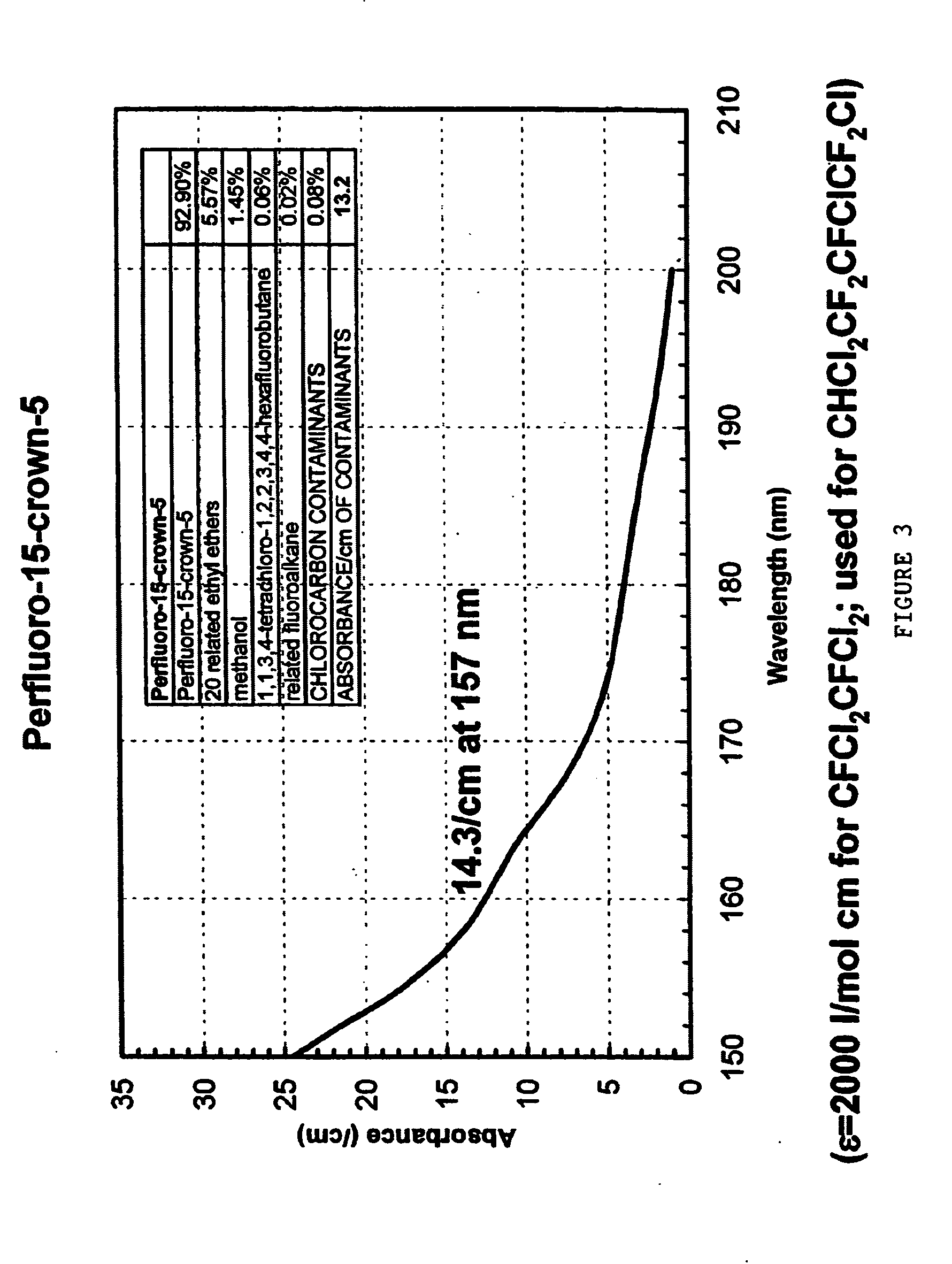Optical fluids, and systems and methods of making and using the same
a technology of optical fluids and optical fluids, applied in the field of optical fluids, can solve the problems of increasing, increasing the difficulty of achieving resolution improvements via conventional means, such as wavelength reduction, and growing mor
- Summary
- Abstract
- Description
- Claims
- Application Information
AI Technical Summary
Benefits of technology
Problems solved by technology
Method used
Image
Examples
example 1
Purification of Perfluorotriglyme
[0116] Perfluorotriglyme (Exfluor, specially ordered as described above) is distilled at atmospheric pressure using a 12-inch Vigreux column and heat is supplied via a standard heating mantle. The heating rate is controlled so as to maintain a slow, steady rate of condensate (about 2-3 mL / min). The first fraction (10%) is collected between 95-105 C and discarded, and the second fraction (80%) is collected at exactly 105 C (uncorrected) and when the temperature began to change the collection is stopped.
[0117] Both of the collected fractions exhibit lower levels (approximately 40-55 ppm) of high boiling impurities (some of which are believed to be chlorinated) that absorb heavily at 157 nm, as compared to the levels detected in the original material of approximately 110 ppm. Gas chromatographs of the results of this purification step for the starting material and the second fraction are shown in FIG. 6(A) and (B). As shown in FIG. 7, the second frac...
example 2
[0118] Other perfluoroethers will be purified using the methods described herein. For distillation purification, the boiling points for some perfluoroethers are:
PerfluoroetherBoiling point (C.)Perfluoro-6,6-Bis(Propyloxymethyl)-4,8-232Dioxaundecane(CF3)2CFOCF2CF2OCF(CF3)2115CF3OC(CF3)2OCF2CF2OCF(CF3)2144Perfluoro[(1-methoxy-1-130-140methylethyl)cyclo-hexane]Perfluoro[(1-ethoxy-1-methylethyl)cyclo-144-154hexane]Perfluoro[[(1-methoxy-methoxy)-1-146-157methylethyl]-cyclohexane]Perfluoro[(1-methoxy-1-methylethyl)-144-154cycloheptane]Perfluoro[2-methoxy-2-methylpropyl)-144-155cyclopentane]Perfluoro[(1-methoxy-1-114-122methylethyl)cyclo-pentane]Perfluoro[1-methyl-1-propoxyethyl)cyclo-145-156pentane]Perfluoro[(1-methyl-1-isopropoxyethyl)-144-154cyclopentane]Perfluoro[[1 -(ethoxy-methoxy)-1-methyl-147-158ethy]cyc1opentane]Perfluoro[(2-ethoxy-1,1-dimethylethoxy)-149-159cyclopentane]
example 3
Alternative Purification of Perfluorotriglyme
[0119] A short column of silica gel (4″×0.5″) is prepared by pouring dry silica into a glass tube. Perfluorotriglyme (Exfluor, specially ordered as described above) is then introduced onto the top of the column and allowed to flow through its length. The first few percent of collected material is discarded and next 60% is saved and analyzed. As shown in FIG. 8, the high boiling impurities (some believed to be chlorinated) originally observed in the starting material were reduced from about 110 ppm to about 3 ppm, and as a result, the purified sample exhibited higher transparency below 220 nm.
[0120] Other perfluoroethers will be purified using this or a substantially similar method.
PUM
| Property | Measurement | Unit |
|---|---|---|
| wavelength | aaaaa | aaaaa |
| width | aaaaa | aaaaa |
| wavelength | aaaaa | aaaaa |
Abstract
Description
Claims
Application Information
 Login to View More
Login to View More - R&D
- Intellectual Property
- Life Sciences
- Materials
- Tech Scout
- Unparalleled Data Quality
- Higher Quality Content
- 60% Fewer Hallucinations
Browse by: Latest US Patents, China's latest patents, Technical Efficacy Thesaurus, Application Domain, Technology Topic, Popular Technical Reports.
© 2025 PatSnap. All rights reserved.Legal|Privacy policy|Modern Slavery Act Transparency Statement|Sitemap|About US| Contact US: help@patsnap.com



